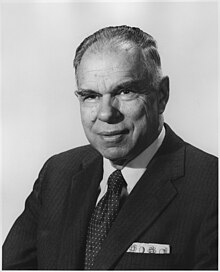
Back غلين سيبورغ Arabic جلين سيبورج ARZ Glenn T. Seaborg AST Qlenn Teodor Siborq Azerbaijani قلن سیبورق AZB Glenn T. Seaborg BAN Глен Тэадор Сібарг Byelorussian Глен Сиборг Bulgarian গ্লেন থিওডোর সিবর্গ Bengali/Bangla Glenn Theodore Seaborg Catalan
It has been suggested that Glenn T. Seaborg bibliography be merged into this article. (Discuss) Proposed since December 2023. |
Glenn T. Seaborg | |
|---|---|
 Seaborg in 1964 | |
| Born | Glen Theodore Seaborg April 19, 1912 |
| Died | February 25, 1999 (aged 86) |
| Education | |
| Known for | Contributions to the synthesis, discovery and investigation of ten transuranium elements |
| Spouse | |
| Children | 7, including David |
| Awards |
|
| Scientific career | |
| Fields | Nuclear chemistry |
| Institutions | |
| Thesis | The interaction of fast neutrons with lead (1937) |
| Doctoral advisors | |
| Doctoral students | |
| Other notable students | Margaret Melhase, Geoffrey Wilkinson |
| Chairman of the United States Atomic Energy Commission | |
| In office March 1, 1961 – August 16, 1971 | |
| Preceded by | John McCone |
| Succeeded by | James R. Schlesinger |
| 2nd Chancellor of the University of California, Berkeley | |
| In office 1958–1961 | |
| Preceded by | Clark Kerr |
| Succeeded by | Edward W. Strong |
| Signature | |
Glenn Theodore Seaborg (/ˈsiːbɔːrɡ/ SEE-borg; April 19, 1912 – February 25, 1999) was an American chemist whose involvement in the synthesis, discovery and investigation of ten transuranium elements earned him a share of the 1951 Nobel Prize in Chemistry.[3] His work in this area also led to his development of the actinide concept and the arrangement of the actinide series in the periodic table of the elements.
Seaborg spent most of his career as an educator and research scientist at the University of California, Berkeley, serving as a professor, and, between 1958 and 1961, as the university's second chancellor.[4] He advised ten US presidents—from Harry S. Truman to Bill Clinton—on nuclear policy and was Chairman of the United States Atomic Energy Commission from 1961 to 1971, where he pushed for commercial nuclear energy and the peaceful applications of nuclear science. Throughout his career, Seaborg worked for arms control. He was a signatory to the Franck Report and contributed to the Limited Test Ban Treaty, the Nuclear Non-Proliferation Treaty and the Comprehensive Test Ban Treaty. He was a well-known advocate of science education and federal funding for pure research. Toward the end of the Eisenhower administration, he was the principal author of the Seaborg Report on academic science, and, as a member of President Ronald Reagan's National Commission on Excellence in Education, he was a key contributor to its 1983 report "A Nation at Risk".
Seaborg was the principal or co-discoverer of ten elements: plutonium, americium, curium, berkelium, californium, einsteinium, fermium, mendelevium, nobelium and element 106, which, while he was still living, was named seaborgium in his honor. He said about this naming, "This is the greatest honor ever bestowed upon me--even better, I think, than winning the Nobel Prize. Future students of chemistry, in learning about the periodic table, may have reason to ask why the element was named for me, and thereby learn more about my work."[5] He also discovered more than 100 isotopes of transuranium elements and is credited with important contributions to the chemistry of plutonium, originally as part of the Manhattan Project where he developed the extraction process used to isolate the plutonium fuel for the implosion-type atomic bomb. Early in his career, he was a pioneer in nuclear medicine and discovered isotopes of elements with important applications in the diagnosis and treatment of diseases, including iodine-131, which is used in the treatment of thyroid disease. In addition to his theoretical work in the development of the actinide concept, which placed the actinide series beneath the lanthanide series on the periodic table, he postulated the existence of super-heavy elements in the transactinide and superactinide series.
After sharing the 1951 Nobel Prize in Chemistry with Edwin McMillan, he received approximately 50 honorary doctorates and numerous other awards and honors. The list of things named after Seaborg ranges from the chemical element seaborgium to the asteroid 4856 Seaborg. He was a prolific author, penning numerous books and 500 journal articles, often in collaboration with others. He was once listed in the Guinness Book of World Records as the person with the longest entry in Who's Who in America.[5]
- ^ "SCI Perkin Medal". Science History Institute. May 31, 2016. Retrieved March 24, 2018.
- ^ Cite error: The named reference
formemrswas invoked but never defined (see the help page). - ^ "The Nobel Prize in Chemistry 1951". Nobel Foundation. Retrieved August 26, 2012.
- ^ Office of the Chancellor. "Past Chancellors". University of California, Berkeley. Retrieved December 24, 2015.
- ^ a b "UCLA Glenn T. Seaborg Symposium – Biography". www.seaborg.ucla.edu. Retrieved April 25, 2022.